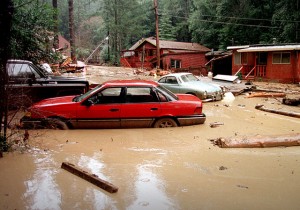The Association of American Geographers (AAG) recently posted an article about the future of California’s drought. They point out that even after multiple dry years, the rains will come back, and if El Nino is as strong as forecast this coming winter, they will return with a vengeance. The writer describes the situation this way:
“They have been called “dry-wet knockouts” because drought weakens ecosystems, and the following floods deliver a “knockout” blow. Vegetation that holds the soil in place withers during droughts, and the soils desiccate and are more easily eroded. Forests become dangerously dry and susceptible to wildfires sparked by summer lightning strikes. Then the knockout: a winter with storm after storm spawned out over the Pacific slams into the west coast. Heavy rains easily erode the fire-charred slopes, washing massive amounts of sediment downhill, eventually choking streams and lakes. The sediments raise the bed-level of rivers, exacerbating floods. Once on the move, the slurry of sediment-laden waters disrupts downstream aquatic ecosystems in ponds, lakes, estuaries, and even the coastal ocean. Dry-wet knockouts become natural disasters for Californians, as economic losses due to drought are compounded by the subsequent devastation of deluges. Homes – sometimes entire neighborhoods – can be buried in massive mudslides; roads and highways buckle as the once-solid earth is eroded out from beneath them; agricultural fields are inundated and crops lost. The floodwaters can take months to finally drain.”
Western climates have a way of swinging from one extreme to another, while in the Southeast changes are often more subtle. What will the impacts of the next “dry-wet” cycle have on California agriculture and the associated markets?
You can read the article here.
